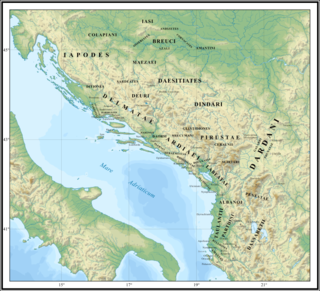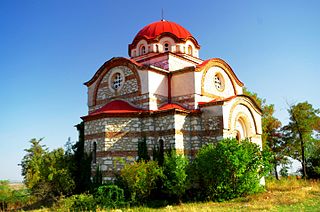Albanians in North Macedonia are ethnic Albanians who constitute the second largest ethnic group in North Macedonia, forming 446,245 individuals or 24.3% of the resident population. Of the 2,097,319 total population in the 2021 census, 619,187 or 29.52% are Albanians.

Scupi is an archaeological site located between Zajčev Rid and the Vardar River, several kilometers from the center of modern Skopje in North Macedonia. A Roman military camp was founded here in the second century BC on the site of an older Dardanian settlement. It became later Colonia Flavia Aelia Scupi and many veteran legionnaires were settled there. A Roman town was founded in the time of Domitian and Scupi became the chief center for romanizing Dardania. It was abandoned in AD 518 during interregnum between Anastasius I Dicorus and Justin I after an earthquake destroyed the city.

Sopište is a municipality in the northern part of North Macedonia. Sopište is also the name of the village where the municipal seat is found. It is located in the Skopje Statistical Region.

Gorno Nerezi is a village in the municipality of Karpoš, North Macedonia. The settlement is situated at an altitude of 771 meters (2532 feet). It is located on the wooded slopes of Mt. Vodno, covers a 7 km radius.
Albanopolis was a city in ancient Roman Macedon specifically in Epirus Nova, the city of the Albanoi, an Illyrian tribe. Albanopolis has been located by various scholars at the modern-day village of Zgërdhesh or at Krujë. The ancient city may correspond with later mentions of the settlement called Arbanon and Albanon during the Middle Ages, although it is not certain this was the same place. The city appears at 150 AD, almost 300 years after Roman conquest of the region.

Dolno Sonje is a village in the municipality of Sopište, North Macedonia. It is located on the other side of Mount Vodno from Skopje, but a road running around the mountain connects the two communities.
Gorno Orizari is a settlement within the Bitola Municipality of North Macedonia. Originally a village, it is now a suburb of the wider city. It is located to the north of the city, east of the exit road for Prilep and close to the proposed M5 motorway, a limited-access road that bypasses Bitola linking the city with Ohrid and Resen (west) and Prilep (north).

The Albanoi were an Illyrian tribe. They were possibly first mentioned by Hecataeus of Miletus under the name Abroi. Ptolemy is the first author who mentions them under the name Albanoi. Their central settlement was called Albanopolis (Ἀλβανόπολις) and was located roughly between the Mat and Shkumbin rivers, in central Albania. The archaeological site of Zgërdhesh has been identified as the likely location of Albanopolis. Stephanus of Byzantium who reproduced Hecataeus added an entry for another settlement named Arbon in Illyria whose inhabitants were called Arbonioi or Arbonites. Another Arbon was recorded by Polybius. John of Nikiû wrote in the 7th century CE about a people known as Arbanitai in the Greek translation of the manuscript.
Gorno Lisiče is a neighbourhood in the City of Skopje, North Macedonia, administered by the Aerodrom Municipality.

Matejče is a village in the municipality of Lipkovo, North Macedonia. The village is known for the Orthodox Monastery of the Most Holy Mother of God, in the Skopska Crna Gora, at a height of 1005 metres, which was built in the 14th century.
Gorno Tateši is a village in the municipality of Struga, North Macedonia.
Gorno Konjare is a village in the municipality of Kumanovo, North Macedonia.
Gorno Orizari is a village in the municipality of Veles, North Macedonia.
Gorno Palčište is a village in the municipality of Bogovinje, North Macedonia.
Gorno Sedlarce is a village in the municipality of Bogovinje, North Macedonia.

Gorno Jelovce is a village in the municipality of Gostivar, North Macedonia.
Gorno Strogomište is a village in the municipality of Kičevo, North Macedonia. It used to be part of the former Zajas Municipality.

Duf is a village in the municipality of Mavrovo and Rostuša, North Macedonia.

Gorno Konjari is a village in the municipality of Petrovec, North Macedonia.
Borka Dragojević-Josifovska, in Serbian: Борка Драгојевић-Јосифовска was a Bosnian archaeologist, museum curator, numismatist and philologist, who was Professor of Classical Philology at Ss. Cyril and Methodius University of Skopje, and who worked mainly on classical archaeology in North Macedonia.










